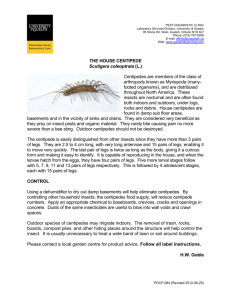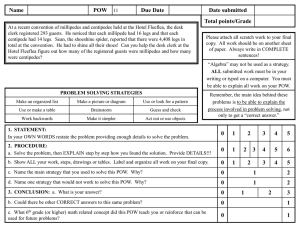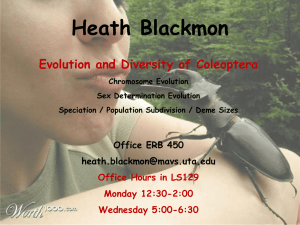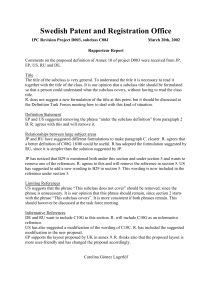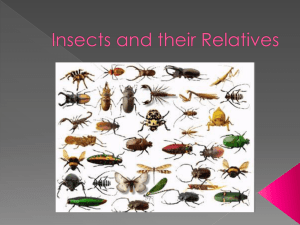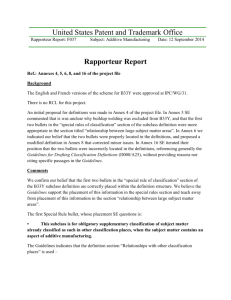PPT - Missouri State University
advertisement
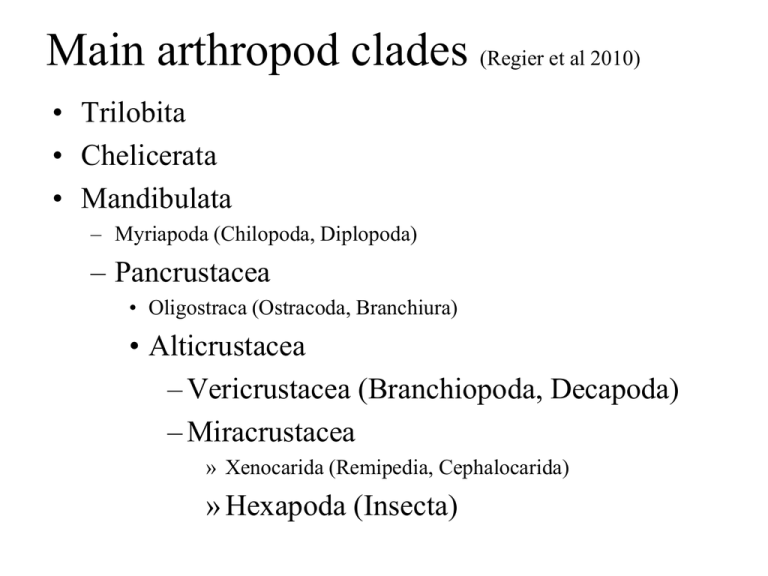
Main arthropod clades (Regier et al 2010) • Trilobita • Chelicerata • Mandibulata – Myriapoda (Chilopoda, Diplopoda) – Pancrustacea • Oligostraca (Ostracoda, Branchiura) • Alticrustacea – Vericrustacea (Branchiopoda, Decapoda) – Miracrustacea » Xenocarida (Remipedia, Cephalocarida) » Hexapoda (Insecta) Mandibulata • Appendages of third post-acron segment modified as mandibles for chewing. • Myriapods, Crustaceans, Hexapods all have mandibles. – Probable syapomorphy…but there are differences in mandible structure – Myriapod and hexapod jaws are uniramous (one-piece), crustacean jaws are jointed, at least during development “Uniramia” • Now discounted hypothesis linking Myriapoda and Hexapoda • Head: acron plus 4 segments: 1 pair antennae, 1 pair mandibles, 2 pair maxillae • Uniramous limbs and mandibles • Tracheal system for gas exchange air-breathers • Malphigian tubules for excretion purines as nitrogenous waste product • Now these appear to be homoplasies (convergent). Latest hypothesis of Arthropod phylogeny (Regier et al 2010, Nature) Class Myriapoda Subclass Chilopoda- centipedes • 2800 species in 5 orders • 1 pair antennae, jaws, 2 pair maxillae, one pair of poison maxillipeds • Dorsoventrally flattened • 15-191 pairs of legs (never 50 though!) • all are carnivorous • Mating by spermatophores 2 superorders and 5 orders of Chilopoda Anamorpha ? Epimorpha Chilopod phylogeny from: Edgecombe, G.D., G. Giribet, and W.C. Wheeler. 1999. Phylogeny of Chilopoda: Combining 18S and 28S rRNA sequences and morphology. In A. Melic, J.J. de Haro, M. Mendez and I. Ribera (eds.), Evolución y Filogenia de Arthropoda. Boletín de la Sociedad Entomológica Aragonesa, 26: 293-331. Subclass Chilopoda- centipedes Superorder Epimorpha • eggs brooded by female • young hatch with full number of segments • Includes scolopendromorphs and geophilomorphs O. Scolopendromorpha large epimorphs, with 21 or 23 pairs of legs Missouri glade scorpion is Scolopendra – can exceed 6 inches in length Another Scolopendra from S. Arizona Scolopendra The “bite” (really a pinch) is toxic but not usually serious. Several species are commonly sold as “pets”. Female apparently allows young to feed from her leg joints for weeks O. Geophilomorpha earth centipedes- elongate, eyeless burrowers, with 191-310 pairs of legs Specimen from Buseik WLA Subclass Chilopoda Superorder Anamorpha • eggs not brooded • young hatch with reduced number of segments and add segments at subsequent molts • O. Lithiobiomorpha stone centipedes 15 pairs of legs • O. Scutigeromorpha house centipedes 15 pairs of very long legs, compound eyes, hemocyanin, dorsal spiracles. O. Lithiobiomorpha stone centipede- Lithobius Common in Missouri woodlands From Busiek WLA O. Scutigeromorpha House centipede Scutigera coleaptrata Introduced into North America from Europe Median dorsal spiracles Subclass Diplopoda- millipedes • More diverse than centipedes About 10,000 known species in 15-17 orders • 1 pair antennae, jaws, first maxillae fused, second pair lost • Compound eyes • Tagma: collum, diplosegments • Detritivorous, herbivorous • Repugnatorial secretions Reproduction in millipedes • Males have 1 or 2 pairs of limbs modified as gonopods for copulation • Females make underground nest chamber lined with fecal secretions • Young hatch with 3 pairs of legs and add segments with each molt to maturity • Long lifespan and delayed sexual maturity in some species Subclass Diplododa Order Polyxenida • Tiny, hairy, can be mistaken for dermestid beetle larvae. A millipede “porcupine” Polyxenus fasciculatus (Tom Eisner, Cornell) Subclass Diplododa Order Spirobolida • Cylindrical body • Includes the largestbodied U.S. species: Narceus • Benzoquinone secretion Narceus americanus- widespread in eastern US, common in Ozark woodlands Subclass Diplododa Order Polydesmida • Dorsoventrally flattened, with lateral dorsal paranota • Colorful, common in woodlands • Can produce cyanide gas from the ozopores Polydesmida Xystodesmidae Apheloria White Rock, Franklin Co AR 10 12 1 4 1 5 13 Order Callipodida From Buseik WLA Order Julida from Buseik WLA Ecological significance of millipedes • Most are detritivores, and they are often very abundant. • Role in breakdown of leaves and woody debris and recycling of cellulose • Occasional pest status- especially introduced species, eg. Black Portuguese millipede Ommatoiulus moreletti in Australia Arthropleura is a fossil myriapod from the Upper Carboniferous (~335 mya) up to 2.5 meters long Arthropleura tracks from Crail, Scotland Reconstructions of some of the largest paleozoic arthropods (a) eurypyterid, b) trilobite, c) insect, e) myriapod
